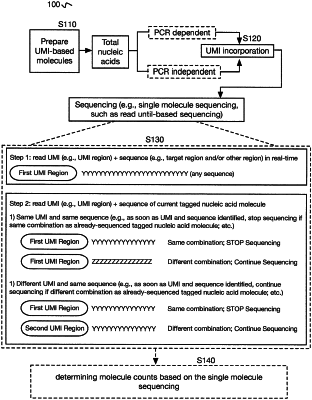| CPC C12Q 1/6869 (2013.01) [C12Q 1/6806 (2013.01); C12Q 2525/161 (2013.01); C12Q 2535/122 (2013.01); C12Q 2537/159 (2013.01); C12Q 2537/165 (2013.01)] | 18 Claims |

|
1. A method for improved single molecule sequencing, the method comprising:
preparing a set of unique molecular identifier (UMI)-based molecules including target-associated regions complementary to target sequence regions of a set of target nucleic acid sequences;
generating a set of tagged nucleic acid molecules based on the set of UMI-based molecules and a set of nucleic acid molecules corresponding to the set of target nucleic acid sequences by:
generating a PCR-amplified subset of nucleic acid molecules using a PCR amplification process with a first subset of nucleic acid molecules of the set of nucleic acid molecules; and
generating the set of tagged nucleic acid molecules using the PCR-amplified subset of nucleic acid molecules and a PCR-independent subset of nucleic acid molecules of the set of nucleic acid molecules, wherein each tagged nucleic acid molecule of the set of tagged nucleic acid molecules comprises:
a UMI region comprising a set of random “N” bases, wherein each random “N” base is selected from any one of an “A” base, a “G” base, a “T” base, and a “C” base; and
a target region corresponding to a target nucleic acid sequence of the set of target nucleic acid sequences; and
performing single molecule sequencing by:
determining a comparison between a first set of sequence regions and a second set of sequence regions,
wherein the first set of sequence regions comprises a first UMI region and a first target region of a sequenced tagged nucleic acid molecule of the set of tagged nucleic acid molecules, and
wherein the second set of sequence regions comprises a second UMI region and a second target region of a tagged nucleic acid molecule of the set of tagged nucleic acid molecules; and
stopping sequencing of the tagged nucleic acid molecule based on the comparison between the first set of sequence regions and the second set of sequence regions.
|